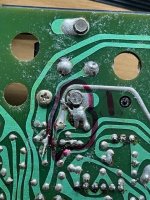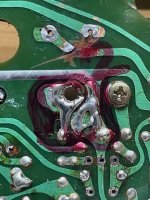I purchased a NAD 3130 on Facebook Marketplace with one channel dead, the other is working. On removing the two To3 Transistors (2N3055 & MJ2955) I noticed that the track on the PCB from the transistor fixing bolt hole was bridged with solder to the adjacent track, as I have marked in red in the attached photo 1 & 2. In photo 1 you can see the solder bridge between the fixing bolt and the adjacent track and in 2 you can see I have removed the bridge. This amp has been repaired before, is this a modification I'm not aware of or just a poor previous repair?
I have the service manual and from what I can see the short in the photos should not be there on either transistor?
Any help or advice would be welcomed..
I have the service manual and from what I can see the short in the photos should not be there on either transistor?
Any help or advice would be welcomed..
Attachments
Thanks, you are correct, I have just found that section in the service manual. Would you recommend replacing all the caps or not?
I will replace both pairs of TO3’s, plus the two other blown transistors Q412, Q404 & burnt resistor R460. To see if I have restored the channel, then I can see what else needs to be done.
Thanks
David.
Thanks
David.
If replacing the original hometaxial 2N3055/2955's with modern parts remember to modify the circuit to include 0.47 ohm emitter resistors to prevent thermal runaway and output stage destruction.
Why would the replacement 2N3055/2955 need emitter resistor changing and would that be R460/R459 or R440/R439 on the NAD3130?
Hi Karl, I doubt it ever had homotaxial transistors - I've always understood the homotaxial process to have been superceded & stopped several years prior to release of the 3130 (mid '70's ?).
My circuit shows it doesn't have any emitter resistors and therein lies the problem for bias stability, it will be very prone to thermal runaway.Why would the replacement 2N3055/2955 need emitter resistor changing and would that be R460/R459 or R440/R439 on the NAD3130?
Thanks 🙂 you could be right... and I don't know for sure but any amp like this with no emitter resistors could (I think) be asking for trouble with regard to thermal stability. I would definitely include them for reliability.Hi Karl, I doubt it ever had homotaxial transistors - I've always understood the homotaxial process to have been superceded & stopped several years prior to release of the 3130 (mid '70's ?).
Thanks for all the replies, I’m currently waiting on parts and will update when fitted. Do I need to consider any other modifications/upgrades if and when it’s working again?
Further my previous post, this 3130 has had prior repair attempts as you possible saw the damaged tracks in my attached photos. I have found today that a BD139 & BD140 have been fitted at Q411 & Q413 instead of the 2SB649a and 2SD669a, obviously incorrect. I'm still waiting for replacement parts to arrived, so I decided to look for any further anomalies, and found that the collector resistor R416 on the working side was reading higher than the 1 ohm, so I removed and it read 4.4K? I have replaced 1 ohm resistors on both side, could the fitting of the BD139 /DB140 have caused the 1 ohm to go high and could this have damaged or affected the MJ2955 and 2N3055 on the working side?
I would have thought the BD139/140 were a reasonable choice tbh to use as common replacements for the driver transistors. The 1 ohm is only used for testing and setting the bias current and is normally linked out. Whatever killed the 1 ohm is unlikely to be those transistors alone, much more likely a fault that just caused high current to flow... or thermal runaway as I mentioned earlier... or the resistor has been left in circuit when it should have been shorted out.
The BD139/140 are not listed as equivalents, however, I have replacements fitted. When completing the final adjustment A & B I think I understand but in Step C do I have to bridge/short the track again and then remove it for Step D as listed in the service manual?
They won't be listed but there are many suitable devices that can be used for all these common parts. The 2SD/2SB's are are Hitachi parts and the BD's are European.
The NAD (according to the diagrams) uses 'select on test' values for setting the bias current and that is a very real issue. You must have the bias on minimum when powering up for the first time and that means snipping Rx1 and/or Rx2 as appropriate along with the resistor in parallel with it. That gives minimum bias. If all is OK I recommend tagging a preset place of the resistors for bias adjustment. Preset value depends on what was fitted but I would think 1k or perhaps even 470 ohm would be suitable.
Also use a DBT for initial testing.
The NAD (according to the diagrams) uses 'select on test' values for setting the bias current and that is a very real issue. You must have the bias on minimum when powering up for the first time and that means snipping Rx1 and/or Rx2 as appropriate along with the resistor in parallel with it. That gives minimum bias. If all is OK I recommend tagging a preset place of the resistors for bias adjustment. Preset value depends on what was fitted but I would think 1k or perhaps even 470 ohm would be suitable.
Also use a DBT for initial testing.
Smoke comes out when you forget to short the 1 ohm out. Ask me how I know... 😆Whatever killed the 1 ohm ..... or the resistor has been left in circuit when it should have been shorted out.
Ok, after the initial power up was successful having clipped RX 1/2 and tagging in two resistors. When competing Step C do I have to bridge/short the track again and then remove it for Step D as listed in the service manual?
You have to have the 1 ohm in place until you are ready to put the top back on and call it fixed.
Get the bias correct and then either leave a preset fitted or select a suitable combination of resistors to equal the value of the preset and fit those in its place. Make sure the bias is really correct and that it does not increase as the amp heats up. You can play the amp at low volume with the 1 ohm in place to heat the amp more. When you are happy short the 1 ohm out.
Get the bias correct and then either leave a preset fitted or select a suitable combination of resistors to equal the value of the preset and fit those in its place. Make sure the bias is really correct and that it does not increase as the amp heats up. You can play the amp at low volume with the 1 ohm in place to heat the amp more. When you are happy short the 1 ohm out.
- Home
- Amplifiers
- Solid State
- NAD 3130 PCB Track layout

